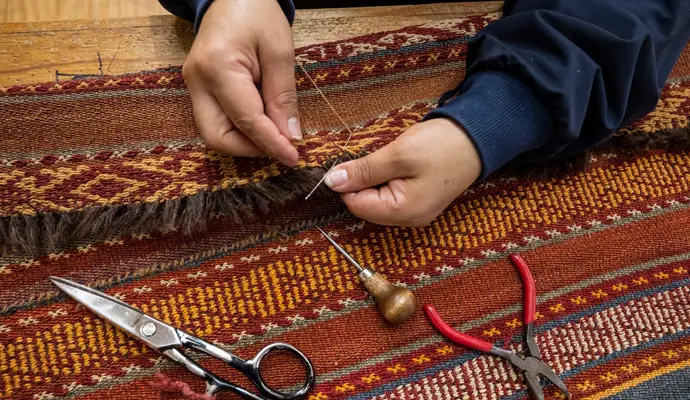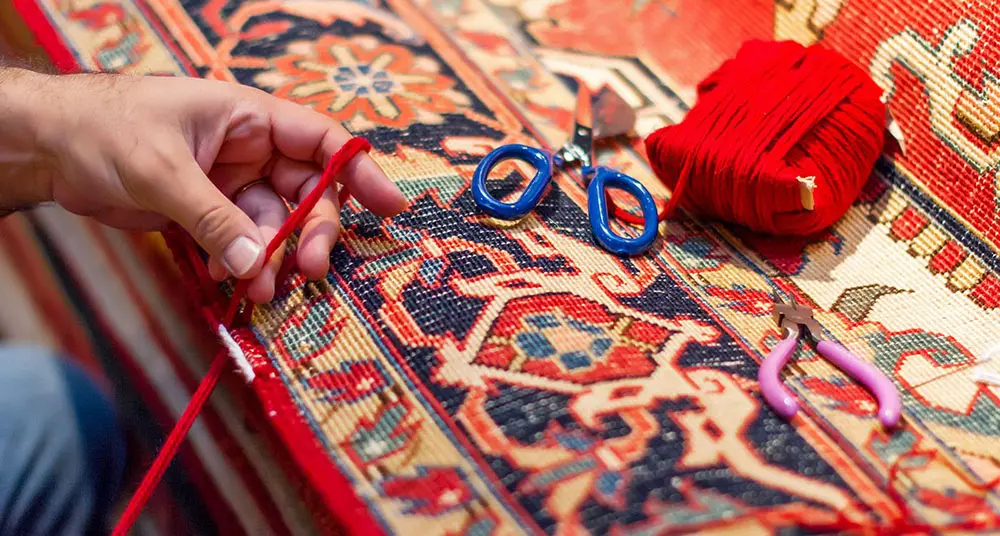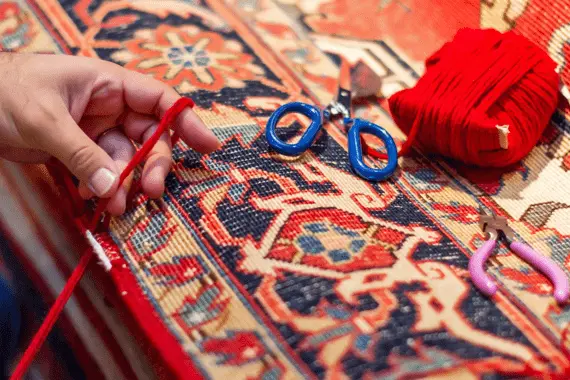Oriental rugs are known for their exquisite beauty and intricate designs. They can add a touch of elegance and charm to any home. However, these rugs may show signs of wear and tear, such as fading, fraying, and staining. This is where restoration comes in. With the proper techniques and tools, damaged and worn-out oriental rugs can be restored to their former glory, preserving their beauty and value for years.
In this ultimate guide to oriental rug restoration, we will explore everything you need to know to restore your precious rugs. We will cover the common problems that oriental rugs face, such as moth damage, fading, and tears, and provide tips on how to fix them. We will also discuss the various restoration techniques available, from cleaning and reweaving to dyeing and patching, and provide step-by-step instructions on how to apply them.
Whether you are a rug collector, a homeowner, or a professional restorer, this guide will provide you with the essential tips and tricks to restore oriental rugs to their original beauty. So, let’s dive in and discover the secrets of oriental rug restoration!
Oriental Rug Restoration – Bringing Old Oriental Rugs Back to Life: Restoration Methods
Over time, these rugs may become damaged or worn out, losing their original beauty and luster. The good news is that with the proper oriental rug restoration methods, old oriental rugs can be brought back to life, restoring their beauty and value.
One of the most common restoration methods for oriental rugs is cleaning. Over time, dirt and dust can accumulate in the fibers of a rug, causing discoloration and damage. Professional rug cleaning services use specialized equipment and cleaning agents to remove dirt and stains from the rug without causing further damage. Another standard restoration method is reweaving. Reweaving involves carefully recreating damaged or missing sections of a rug’s pattern by hand, using matching fibers and knotting techniques. This technique can restore the rug’s original structure and design.

Another popular restoration method is dyeing. Dyeing can be used to restore the original colors of a faded rug or to change the colors to a more modern aesthetic. To dye a rug, the fibers must first be cleaned and treated with a mordant to prepare them for dyeing. Then, the dye is applied to the rug in a careful and controlled manner, ensuring even coverage and saturation. After the dyeing process, the rug is rinsed and dried. Any necessary touch-ups or repairs are made to complete the restoration process. With these and other oriental rug restoration methods, old oriental rugs can be brought back to life, preserving their beauty and value for generations.
In addition to the oriental rug restoration methods mentioned in the previous paragraphs, several other techniques can bring old oriental rugs back to life.
One such technique is patching. Patches can repair small holes or tears in a rug’s surface and are made from matching fibers and colors to blend seamlessly with the rug’s original design. This technique is beneficial for rugs with localized damage or wear and can prevent further damage from occurring.
Another technique is overcasting, which involves wrapping the edges of a rug in a protective yarn to prevent fraying and wear. Depending on the desired aesthetic, overcasting can be done in a matching or contrasting color. It can help extend a rug’s life by protecting its edges from damage.
Finally, it’s worth noting that not all oriental rug restoration methods are suitable for every rug. Before attempting any restoration work, it’s essential to assess the rug’s condition and determine which techniques are appropriate for its sustained damage. In some cases, it may be best to consult with a professional rug restorer, who can provide expert guidance and advice on the most effective restoration methods for a particular rug.
Oriental Rug Restoration – Professional vs. DIY Restoration: Which is Right for You?
Restoring an oriental rug can be challenging and time-consuming, requiring specialized knowledge, tools, and materials. As such, many people may wonder whether to attempt a DIY restoration or hire a professional rug restorer. In this section, we’ll explore the pros and cons of each approach to help you decide which is right for you.
DIY Oriental Rug Restoration: The main advantage of a DIY restoration is cost savings. By doing the work yourself, you can save money on labor and other expenses associated with hiring a professional. Additionally, restoring your rug is rewarding and satisfying, and you enjoy the accomplishment of completing a complex project.
However, DIY oriental rug restoration can also be risky. Without specialized knowledge and experience, it’s easy to accidentally damage the rug or use the wrong techniques or materials. This can result in irreversible damage or a subpar restoration that detracts from the rug’s value and beauty.
Professional Oriental Rug Restoration: Hiring a professional rug restorer can be an excellent option for ensuring a high-quality restoration. Professional restorers have the specialized knowledge, experience, and tools to restore oriental rugs to their original beauty and luster. Additionally, professional restorers often offer guarantees or warranties on their work, providing peace of mind and protection against further damage.
The main drawback of hiring a professional is cost. Professional oriental rug restoration services can be expensive, particularly for complex restoration projects or for rare or valuable rugs. Additionally, there may be a wait time for professional services, as skilled rug restorers are often in high demand.
Deciding between DIY and professional restoration depends on various factors, including your budget, experience and knowledge, and the extent and nature of the rug’s damage. For complex or valuable rugs, it may be best to seek the expertise of a professional restorer. In contrast, a DIY approach may be more feasible for less complex restorations.
Oriental Rug Restoration – Finding and Working with Professional Oriental Rug Restorers
When it comes to restoring an oriental rug, it’s important to work with a professional who has the specialized knowledge, experience, and tools needed to do the oriental rug restoration job right. This section will explore tips for finding and working with professional oriental rug restorers.
- Please research: Ensure they have the appropriate qualifications and experience before choosing a rug restorer. Look for online reviews and ratings, and ask for references or examples of their past work.
- Check their credentials: Professional rug restorers should be certified by a reputable organization such as the Association of Rug Care Specialists or the Institute of Inspection, Cleaning and Restoration Certification (IICRC).
- Ask about their restoration process: A good rug restorer should be able to provide you with a detailed explanation of their restoration process, including the techniques and materials they use. They should also be able to identify any potential challenges or risks associated with your specific rug.
- Get a quote: Before committing to a rug restoration, ask for a detailed quote outlining the project’s costs and timeframe. Be wary of restorers offering meager prices or pressuring you to decide quickly.
- Communicate clearly: Throughout the restoration process, communicate clearly with your rug restorer to meet your expectations. Ask questions, provide feedback, and voice concerns or issues.
- Follow aftercare instructions: Once the restoration is complete, follow any aftercare instructions provided by your rug restorer. This may include cleaning, storage, and maintenance recommendations to ensure your rug remains in good condition.
In summary, finding and working with a professional oriental rug restorer requires careful research and communication. By following these tips, you can ensure that your rug is in good hands and that the restoration process is successful.
Final Thoughts
If you need a professional and qualified oriental rug restorer, look no further than Shabahang Royal Carpet, with years of experience and a team of skilled restorers dedicated to preserving and restoring the beauty and value of your rug. Our restoration process is based on traditional techniques and materials, ensuring that your rug is restored to its original condition while maintaining its authenticity and cultural significance. Shabahang Rugs also offers cleaning services, appraisal, and conservation services, making them a one-stop shop for all oriental rug needs. Contact us today to learn more about their services and schedule a consultation.



